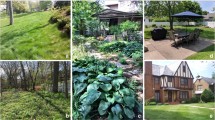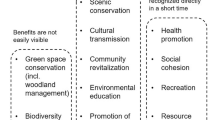Abstract
The residential yard is an integral part of the urban ecosystem. Individual preferences and social expectations influence homeowners’ yard care choices, which in turn affect urban ecology. However, little is known about residents’ conceptions of their yards as part of the urban ecosystem. We asked how homeowners conceive of their yard as part of the urban ecosystem by examining urban ecosystem concepts embedded within homeowners’ descriptions and stories of their yards. Our study sites included an urban and suburban area in the Saint Paul-Minneapolis metropolitan area of Minnesota, USA. We found that people’s understandings of their yards as urban ecosystems are complex but have prominent gaps. Salient concepts included biotic and abiotic interactions within the yard, linkages of human inputs and weeds across yards and watersheds, and yards as social space. Stories described managing dynamic ecological processes within yards to maintain a steady state and limiting linkages of human inputs beyond the yard. Prominent gaps included ecological cycles, biodiversity, and ecosystem services within yards and ecological linkages across yards. In general, people conceived of their yards in terms of inputs rather than cycles and in terms of creating barriers between their yards and surrounding areas rather than fostering ecological interconnections across them. We provide recommendations for resident outreach programs based on our findings. Finally, our study presents a challenge to urban ecosystem research to unravel where there are gaps in understandings of urban ecosystems versus where there is resistance to incorporating certain ecological interactions within the residential yard.


Similar content being viewed by others
Notes
We conducted two non-response bias tests to compare survey respondents with the general population of the study areas: a comparison to Lino Lakes census data and a comparison of 1st wave respondents to 2nd wave respondents who might be more similar to the average resident. These tests indicate our survey respondents may contain biases for households that have owned their home slightly longer, identify racially as white, have slightly higher levels of education and income, and are slightly older. We also compared survey respondents who participated in discussions (“discussants”) with those who did not (“survey-only respondents”) in these two communities on a variety of criteria including: 1) demographic variables (i.e. education, race, length of homeownership, income, home value, children living at home, age, lot size) and 2) basic yard care (i.e. fertilizing, watering, knowledge of lawn inputs). Discussants and survey-only respondents showed no significant differences in regard to these variables, with the exception of Highland Park discussants being slightly older with fewer children living at home than Highland Park survey-only respondents, and Lino Lakes discussants being more educated than Lino Lakes survey-only respondents.
For the following section, participants’ quotes are identified by meeting location, meeting number, and participant ID: “HP” indicates Highland Park, and “LL” indicates Lino Lakes; the number following HP or LL indicates the meeting number in Session One (1–4); and the last number indicates the participant’s ID.
Creeping Charlie (Glechoma hederacea) is a perennial that grows low to the ground. It grows well in shade but can also grow in sunny areas (Brown 2000).
References
Alumai A, Grunkemeyer M, Kovach J, Shetlar DJ, Cardina J, Rimelspach J, Clayton S, Grewal PS (2010) Implementing integrated pest management in professional lawn care: a case study. Urban Ecosys 13(1):37–49
Arcury TA, Christianson EH (1993) Rural–urban differences in environmental knowledge and actions. J Environ Educ 25(1):19–25
Berkowitz AR, Nilon CH, Hollweg KS (2003) Understanding urban ecosystems: a new frontier for science and education. Springer, New York
Blaine TW, Clayton S, Robbins P, Grewal PS (2012) Homeowner attitudes and practices towards residential landscape management in Ohio, USA. Environ Manag 50:257–271
Brossard D, Lewenstein B, Bonney R (2005) Scientific knowledge and attitude change: the impact of a citizen science project. Int J Sci Educ 27(9):1099–1121
Brown DL (2000) Yard and garden brief: Creeping Charlie. http://www.extension.umn.edu/yardandgarden/ygbriefs/h510creepingcharlie.html. Accessed 22 August 2012
Buijs AE, Fischer A, Rink D, Young JC (2008) Looking beyond superficial knowledge gaps: understanding public representations of biodiversity. Int J Biodivers Sci Manag 4:65–80
Byrne LB, Grewal P (2008) Introduction to ecological landscaping: a holistic description and framework to guide the study and management of urban landscape parcels. CATE 1(2)
Cadenasso ML, Pickett STA (2008) Urban principles for ecological landscape design and management: scientific fundamentals. CATE 1(2)
Carey RO, Hochmuth GJ, Martinez CJ, Boyer TH, Nair VD, Dukes MD, Toor GS, Shober AL, Cisar JL, Trenholm LE, Sartain JB (2012) A review of turfgrass fertilizer management practices: implications for urban water quality. Hort Technol 22(3):280–291
Clayton S (2007) Domesticated nature: motivations for gardening and perceptions of environmental impact. J Env Psychol 27(3):215–224
Cook EM, Hall SJ, Larson KL (2012) Residential landscapes as social-ecological systems: a synthesis of multi-scalar interactions between people and their home environment. Urban Ecosyst 15(1):19–52
Dahmus ME, Nelson KC, Woodside A (2011) Lawn and yard care choices. http://www.tchep.umn.edu/prod/groups/cfans/@pub/@cfans/@tchep/documents/asset/cfans_asset_378868.pdf
Fissore C, Hobbie SE, King JY, McFadden JP, Nelson KC, Baker LA (2012) The residential landscape: fluxes of elements and the role of household decisions. Urban Ecosyst 15(1):1–18
Goddard MA, Dougill AJ, Benton TG (2010) Scaling up from gardens: biodiversity conservation in urban environments. Trends Ecol Evol 25(2):90–98
Goffman P, J Cavender-Bares, ND Bettez, JM Grove, SJ Hall, JB Hefferman, SE Hobbie, KL Larson, JL Morse, C Neill, KC Nelson, J O’Neil-Dunne, L Ogden, D Pataki (2013) Ecological homogenization of urban America. http://www.urbanhomogenization.org/
Grimm NB, Baker LJ, Hope D (2003) An ecosystem approach to understanding cities: familiar foundations and uncharted frontiers. In: Berkowitz AR, Nilon CH, Hollweg KS (eds) Understanding urban ecosystems: a new frontier for science and education. Springer, New York, pp 95–114
Gustafson P (2001) Meanings of place: everyday experiences and theoretical conceptualizations. J Environ Psychol 21(1):5–16
Herringshaw CJ, Thompson JR, Stewart TW (2010) Learning about restoration of urban ecosystems: a case study integrating public participation, stormwater management, and ecological research. Urban Ecosyst 13:535–562
Jordan R, Singer F, Vaughan J, Berkowitz A (2009) What should every citizen know about ecology? Front Ecol Environ 7(9):495–500
Kramp MK (2004) Exploring life and experience through narrative inquiry. In: de Marrais K, Lapan SD (eds) Foundations for research: methods of inquiry in education and the social sciences. LEA, Mahwah, pp 103–121
Krueger RA, Casey MA (2000) Focus groups: a practical guide for applied research. Sage, Thousand Oaks
Larson KL, Casagrande D, Harlan SL, Yabiku ST (2009) Residents’ yard choices and rationales in a desert city: social priorities, ecological impacts, and decision tradeoffs. Environ Manag 44:921–937
Lerman SB, Warren PS (2011) The conservation value of residential yards: linking birds and people. Ecol Appl 21(4):1327–1339
Main MB (2004) Mobilizing grass-roots conservation education: the Florida Master Naturalist Program. Conserv Biol 18(1):11–16
Martin LE, MG Sorice, UP Kreuter (2011) Understanding and influencing urban residents’ knowledge about wildland management in Austin, Texas. Urban Ecosyst Online First
McDaniel J, Alley KD (2005) Connecting local environmental knowledge and land use practices: a human ecosystem approach to urbanization in West Georgia. Urban Ecosyst 8(1):23–38
McIntyre NE, Hostetler ME (2001) Effects of urban land use on pollinator (Hymenoptera: Apoidea) communities in a desert metropolis. Basic Appl Ecol 2:209–218
Metropolitan Council (2012) http://stats.metc.state.mn.us/profile/detail.aspx?c=02395725. Accessed 22 August 2012
Milesi C, Running SW, Elvidge CD, Dietz JB, Tuttle BT, Nemani RR (2005) Mapping and modeling the biogeochemical cycling of turf grasses in the United States. Environ Manag 36(3):426–438
Morrone M, Mancl K, Carr K (2001) Development of a metric to test group differences in ecological knowledge as one component of environmental literacy. J. Environ Educ 32(4):33–42
Munson BH (1994) Ecological misconceptions. J. Environ Educ 25(4):30–34
Nelson KC, Dahmus M, Woodside A (2011) Yard care choices in urban living survey. University of Minnesota, St. Paul
Nerbonne JF, Vondracek B (2003) Volunteer macroinvertebrate monitoring: assessing training needs through examining error and bias in untrained volunteers. J N Am Benthol Soc 22(1):152–163
Nielson L, Smith CL (2005) Influences on residential yard care and water quality: Tualatin Watershed, Oregon. JAWRA 41(1):93–106
Nilon CH, Berkowitz AR, Hollweg KS (1999) Editorial: understanding urban ecosystems: a new frontier for science and education. Urban Ecosyst 3:3–4
Overdevest C, Orr CH, Stepenuck K (2004) Volunteer stream monitoring and local participation in natural resource issues. Hum Ecol Rev 11(2):177–185
Pickett STA, Cadenasso ML, Grove JM, Groffman PM, Band LE, Boone CG, Burch WR Jr, Grimmond CSB, Hom J, Jenkins JC, Law NL, Nilon CH, Pouyat RV, Szlavecz K, Warren PS, Wilson MA (2008) Beyond urban legends: an emerging framework of urban ecology, as illustrated by the Baltimore ecosystem study. BioSci 58(2):139–150
Ramsey County Historical Society (2012) Highland. http://www.rchs.com/highland.htm. Accessed 22 August 2012
Robelia B, T Murphy (2011) What do people know about key environmental issues? A review of environmental knowledge surveys. Environ Educ Res iFirst Article
Rudd H, Vala J, Schaefer V (2002) Importance of backyard habitat in a comprehensive biodiversity conservation strategy: a connectivity analysis of urban green spaces. Restor Ecol 10(2):368–375
Spence PL, Osmond DL, Childres W, Heitman JL, Robarge WP (2012) Effects of lawn maintenance on nutrient losses via overland flow during natural rainfall events. JAWRA 1–16
Sperling CD, Lortie CJ (2010) The importance of urban backgardens on plant and invertebrate recruitment: a field microcosm experiment. Urban Ecosyst 13:223–235
Stewart DW, Shamdasani PN, Rook DW (2007) Focus groups: theory and practice. Sage, Thousand Oaks
Wilder Foundation (2011) http://www.mncompass.org/_pdfs/neighborhood-profiles/StPaul-Highland-102011.pdf. Accessed 22 August 2012
Acknowledgments
This research was supported by the National Science Foundation Dynamics of Coupled Natural and Human Systems Program (BCS-0908998). We thank the survey respondents and discussion participants who participated in this study. We also thank GIS specialist A. Slaats for sample selection and creation of maps of the study sites. Special thanks to A. Woodside for logistical, methodological, and data entry support, K. Will for survey data entry, and L. Dorle for survey coding. We thank R. Brummel, A. Kokotovich, and T. Woods for comments on an earlier version of this article. We also thank our collaborators in our related research study, L. A. Baker, S.E. Hobbie, J. Y. King, and J.P. McFadden.
Conflict of interest
The authors declare that they have no conflict of interest.
Author information
Authors and Affiliations
Corresponding author
Rights and permissions
About this article
Cite this article
Dahmus, M.E., Nelson, K.C. Yard stories: examining residents’ conceptions of their yards as part of the urban ecosystem in Minnesota. Urban Ecosyst 17, 173–194 (2014). https://doi.org/10.1007/s11252-013-0306-3
Published:
Issue Date:
DOI: https://doi.org/10.1007/s11252-013-0306-3




